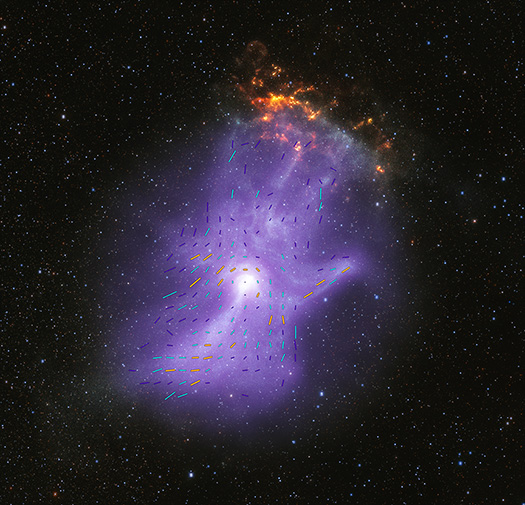Rotating neutron stars with strong magnetic fields, or pulsars, serve as laboratories for extreme physics, offering high-energy conditions that cannot be replicated on Earth. Young pulsars can create jets of matter and antimatter moving away from the poles of the pulsar, along with an intense wind, forming a “pulsar wind nebula”.
In 2001, NASA’s Chandra X-ray Observatory first observed the pulsar PSR B1509-58 and revealed that its pulsar wind nebula (referred to as MSH 15-52) resembles a human hand. The pulsar is located at the base of the “palm” of the nebula. Now Chandra’s data of MSH 15-52 have been combined with data from NASA’s newest X-ray telescope, the Imaging X-ray Polarimetry Explorer (IXPE) to unveil the magnetic field “bones” of this remarkable structure, as reported in our press release. IXPE stared at MSH 15-52 for 17 days, the longest it has looked at any single object since it launched in December 2021.
In a new composite image, Chandra data are seen in orange (low-energy X-rays), green, and blue (higher-energy X-rays), while the diffuse purple represents the IXPE observations. The pulsar is in the bright region at the base of the palm and the fingers are reaching toward low energy X-ray clouds in the surrounding remains of the supernova that formed the pulsar. The image also includes infrared data from the second data release of the Dark Energy Camera Plane Survey (DECaPS2) in red and blue.
The IXPE data provides the first map of the magnetic field in the ‘hand’. It reveals information about the electric field orientation of X-rays determined by the magnetic field of the X-ray source. This is called “X-ray polarization”.


An additional X-ray image shows the magnetic field map in MSH 15-52. In this image, short straight lines represent IXPE polarization measurements, mapping the direction of the local magnetic field. Orange “bars” mark the most precise measurements, followed by cyan and blue bars with less precise measurements. The complex field lines follow the `wrist', 'palm' and 'fingers' of the hand, and probably help define the extended finger-like structures.
The amount of polarization — indicated by bar length — is remarkably high, reaching the maximum level expected from theoretical work. To achieve that strength, the magnetic field must be very straight and uniform, meaning there is little turbulence in those regions of the pulsar wind nebula.
One particularly interesting feature of MSH 15-52 is a bright X-ray jet directed from the pulsar to the “wrist” at the bottom of the image. The new IXPE data reveal that the polarization at the start of the jet is low, likely because this is a turbulent region with complex, tangled magnetic fields associated with the generation of high-energy particles. By the end of the jet the magnetic field lines appear to straighten and become much more uniform, causing the polarization to become much larger.
A paper describing these results by Roger Romani of Stanford University and collaborators was published in The Astrophysical Journal on October 23, 2023, and is available at https://arxiv.org/abs/2309.16067 IXPE is a collaboration between NASA and the Italian Space Agency with partners and science collaborators in 12 countries. IXPE is led by NASA’s Marshall Space Flight Center in Huntsville, Alabama. Ball Aerospace, headquartered in Broomfield, Colorado, manages spacecraft operations together with the University of Colorado's Laboratory for Atmospheric and Space Physics in Boulder.
NASA's Marshall Space Flight Center manages the Chandra program. The Smithsonian Astrophysical Observatory's Chandra X-ray Center controls science operations from Cambridge, Massachusetts, and flight operations from Burlington, Massachusetts.
This release features a composite image of a pulsar wind nebula, which strongly resembles a ghostly purple hand with sparkling fingertips.
A pulsar is a highly magnetized collapsed star that rotates and creates jets of matter flowing away from its poles. These jets, along with intense winds of particles, form pulsar wind nebulae. Here, the pulsar wind nebula known as MSH 15-52 resembles a hazy purple cloud set against a black, starry backdrop.
Both NASA's Chandra X-ray Observatory and the Imaging X-ray Polarimetry Explorer (IXPE) have observed MSH 15-52. Their observations revealed that the shape of this pulsar wind nebula strongly resembles a human hand, including five fingers, a palm and wrist. The bright white spot near the base of the palm is the pulsar itself.
The three longest fingertips of the hand-shape point toward our upper right, or 1:00 on a clock face. There, a small, mottled, orange and yellow cloud appears to sparkle or glow like embers. This orange cloud is part of the remains of the supernova explosion that created the pulsar. The backdrop of stars was captured in infrared light.
|
||||||||||||||||||||||||||||||

| Share This |
|

